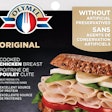
The animal protein supply is constrained and there is little evidence the trend will reverse soon.
In a WATT Poultry Chat interview, Mark Jordan, executive director of LEAP Market Analytics, examined supply and demand trends across beef, pork, chicken and turkey. He said consumers are experiencing sticker shock.
Austin Alonzo: I know you want to talk about the competing proteins market.
Mark Jordan: Just taking a step back and accounting where we are. A lot of the news items that we've been seeing with supply chain disruptions, meat and poultry price inflation and just thinking about where are we, at least in terms of the supply picture.
I've got a per capita availability chart here looking on an annual basis and tackling beef, pork, chicken and turkey for about the last quarter century, and then also with where we are in 2021, and even an outlook into 2022.
I think maybe the concerning thing, if you're further down the value chain is, as a buyer, you look at these high prices, and you're waiting for relief. And really, the data is elusive that is relief is coming. In fact, it looks very broadly as if supplies are going to even be constructed a little bit. The last hogs and pigs report that came out a little over a month ago, the June-August pig crop was about down about 6%. Year over year, a lot of the inventory estimates down fairly significantly and came in below a lot of estimates and expectations.
On the beef side, there's been liquidation in the beef cattle herd to where as you'll look out to next year, looking at a good 1% to 2% decrease in output. We've covered chicken and turkey a lot.
The chicken industry remains constrained by this hatchability issue. And we're looking at very minimal production supply growth next year. The turkey industry, the per capita availability this year is at a 34 year low, maybe the smallest of rebounds next year.
Now, let's pivot to looking at this in aggregate. If you look at where supplies are headed here in 2022, it's going to be noticeably tighter. We go back a few years in the aftermath of the big feed input crunch in 2011 and 2012, there was the the porcine epidemic diarrhea virus (PEDV) outbreak in the swine industry that they dealt with, a lot of liquidation in the cattle herd.
Supplies got really tight back then. We're not talking about taking meat and poultry supply levels back quite that far. But given the inflation we've got, as users looking for more product it's going be a little bit elusive it looks like based on current trends.
Of course, there's the supply argument and supplies is going to be tight. And that's going to create pressure in an already kind of tense value chain. But looking here and we see of course, one of the things we're still following is the demand side pressures. Demand exploded. This is a look at across all proteins, kind of an aggregate view of demand before chicken and turkey. Of course, demand has been very strong here during the last year or so it just exploded to kind of unprecedented levels on an aggregate composite basis.
Now there is starting to be evidence that we're seeing demand retreat a bit. Higher prices are getting passed on to the consumer. And that's kind of working its way, there's some reverberation coming back up the supply chain in terms of signals that prices are high.
We've got some issues here. Consumers are just experiencing sticker shock, and that's having some pushback effect. So that's something also to watch as the demand side is a huge, huge factor in all this in how things are playing out.
This transcript edited for length and clarity.















